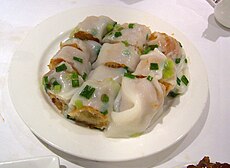Zháliǎng
 |
|
| Course | Dim sum, breakfast |
|---|---|
| Place of origin | Guangdong, China |
| Region or state | Guangdong province, China, Hong Kong, Taiwan |
| Main ingredients | rice noodle roll, youtiao |
| |
|
| Zhaliang | |||||||||||||
| Traditional Chinese | |||||||||||||
|---|---|---|---|---|---|---|---|---|---|---|---|---|---|
| Simplified Chinese | |||||||||||||
| Cantonese Yale | ja léuhng | ||||||||||||
| Cantonese Jyutping | zaa3 loeng5 | ||||||||||||
| Hanyu Pinyin | zháliǎng | ||||||||||||
| Literal meaning | fried twice | ||||||||||||
|
|||||||||||||
| Transcriptions | |
|---|---|
| Standard Mandarin | |
| Hanyu Pinyin | zháliǎng |
| Yue: Cantonese | |
| Yale Romanization | ja léuhng |
| Jyutping | zaa3 loeng5 |
Zhaliang (炸兩) is a Cantonese dim sum. It is made by tightly wrapping rice noodle roll around youtiao (fried dough).
It is often served doused in soy sauce, hoisin sauce or sesame paste and sprinkled with sesame seeds. It is usually eaten with soy milk or congee.
...
Wikipedia
